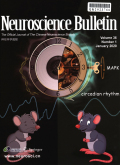- 钛学术文献服务平台 \
- 学术期刊 \
- 医药卫生期刊 \
- 神经病学与精神病学期刊 \
- 神经科学通报(英文版)期刊 \
A Systematic Characterization of Structural Brain Changes in Schizophrenia
A Systematic Characterization of Structural Brain Changes in Schizophrenia
基本信息来源于合作网站,原文需代理用户跳转至来源网站获取
摘要:
A systematic characterization of the similarities and differences among different methods for detecting structural brain abnormalities in schizophrenia,such as voxel-based morphometry (VBM),tensor-based morphometry (TBM),and projection-based thickness (PBT),is important for understanding the brain pathology in schizophrenia and for developing effective biomarkers for a diagnosis of schizophrenia.However,such studies are still lacking.Here,we performed VBM,TBM,and PBT analyses on T1-weighted brain MR images acquired from 116 patients with schizophrenia and 116 healthy controls.We found that,although all methods detected wide-spread structural changes,different methods captured different information-only 10.35% of the grey matter changes in cortex were detected by all three methods,and VBM only detected 11.36% of the white matter changes detected by TBM.Further,pattern classification between patients and controls revealed that combining different measures improved the classification accuracy (81.9%),indicating that fusion of different structural measures serves as a better neuroimaging marker for the objective diagnosis of schizophrenia.

推荐文章
Timing and structural controls on skarn-type and vein-type mineralization at the Xitian tin-polymeta
LA-MC-ICP-MS U-Pb dating
Structure control
Tin-polymetallic deposit
SE China
The use of hydrogeochemical analyses and multivariate statistics for the characterization of thermal
Hydrogeochemistry
Thermal waters
Multivariate statistical analysis
Silica geothermometers
Mixing models
Cold groundwaters
改进的Brain Extraction Tool算法及其在脑实质分割中的应用
BET算法
磁共振图像
脑实质
分割
内容分析
关键词云
关键词热度
相关文献总数
(/次)
(/年)
文献信息
| 篇名 | A Systematic Characterization of Structural Brain Changes in Schizophrenia | ||
| 来源期刊 | 神经科学通报(英文版) | 学科 | |
| 关键词 | |||
| 年,卷(期) | 2020,(10) | 所属期刊栏目 | Original Articles |
| 研究方向 | 页码范围 | 1107-1122 | |
| 页数 | 16页 | 分类号 | |
| 字数 | 语种 | 英文 | |
| DOI | |||
五维指标
引文网络
引文网络
二级参考文献 (60)
共引文献 (8)
参考文献 (90)
节点文献
引证文献 (0)
同被引文献 (0)
二级引证文献 (0)
1991(1)
- 参考文献(1)
- 二级参考文献(0)
1995(2)
- 参考文献(2)
- 二级参考文献(0)
1997(1)
- 参考文献(1)
- 二级参考文献(0)
1998(2)
- 参考文献(2)
- 二级参考文献(0)
1999(1)
- 参考文献(1)
- 二级参考文献(0)
2000(2)
- 参考文献(2)
- 二级参考文献(0)
2001(7)
- 参考文献(4)
- 二级参考文献(3)
2003(5)
- 参考文献(3)
- 二级参考文献(2)
2004(3)
- 参考文献(3)
- 二级参考文献(0)
2005(9)
- 参考文献(6)
- 二级参考文献(3)
2006(3)
- 参考文献(1)
- 二级参考文献(2)
2007(12)
- 参考文献(5)
- 二级参考文献(7)
2008(10)
- 参考文献(4)
- 二级参考文献(6)
2009(16)
- 参考文献(5)
- 二级参考文献(11)
2010(16)
- 参考文献(8)
- 二级参考文献(8)
2011(10)
- 参考文献(3)
- 二级参考文献(7)
2012(11)
- 参考文献(8)
- 二级参考文献(3)
2013(5)
- 参考文献(4)
- 二级参考文献(1)
2014(4)
- 参考文献(2)
- 二级参考文献(2)
2015(11)
- 参考文献(6)
- 二级参考文献(5)
2016(2)
- 参考文献(2)
- 二级参考文献(0)
2017(6)
- 参考文献(6)
- 二级参考文献(0)
2018(5)
- 参考文献(5)
- 二级参考文献(0)
2019(6)
- 参考文献(6)
- 二级参考文献(0)
2020(0)
- 参考文献(0)
- 二级参考文献(0)
- 引证文献(0)
- 二级引证文献(0)
引文网络交叉学科
相关学者/机构
期刊影响力
神经科学通报(英文版)
主办单位:
中国科学院上海生命科学研究院
出版周期:
双月刊
ISSN:
1673-7067
CN:
31-1975/R
开本:
16开
出版地:
上海市岳阳路319号31B楼405室
邮发代号:
4-608
创刊时间:
1985
语种:
eng
出版文献量(篇)
2003
总下载数(次)
1
总被引数(次)
9688
期刊文献
相关文献
推荐文献
- 期刊分类
- 期刊(年)
- 期刊(期)
- 期刊推荐
神经科学通报(英文版)2022
神经科学通报(英文版)2021
神经科学通报(英文版)2020
神经科学通报(英文版)2019
神经科学通报(英文版)2018
神经科学通报(英文版)2017
神经科学通报(英文版)2016
神经科学通报(英文版)2015
神经科学通报(英文版)2014
神经科学通报(英文版)2013
神经科学通报(英文版)2012
神经科学通报(英文版)2011
神经科学通报(英文版)2010
神经科学通报(英文版)2009
神经科学通报(英文版)2008
神经科学通报(英文版)2007
神经科学通报(英文版)2006
神经科学通报(英文版)2005
神经科学通报(英文版)2004
神经科学通报(英文版)2003
神经科学通报(英文版)2002
神经科学通报(英文版)2001
神经科学通报(英文版)2000
神经科学通报(英文版)2020年第9期
神经科学通报(英文版)2020年第8期
神经科学通报(英文版)2020年第7期
神经科学通报(英文版)2020年第6期
神经科学通报(英文版)2020年第5期
神经科学通报(英文版)2020年第4期
神经科学通报(英文版)2020年第3期
神经科学通报(英文版)2020年第2期
神经科学通报(英文版)2020年第12期
神经科学通报(英文版)2020年第11期
神经科学通报(英文版)2020年第10期
神经科学通报(英文版)2020年第1期

 免费查重
免费查重










